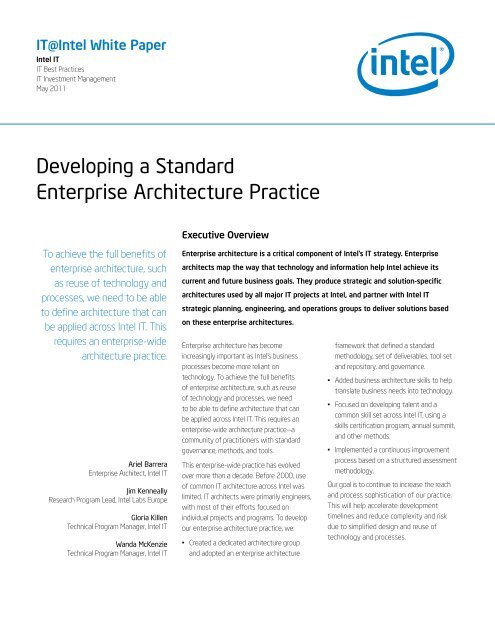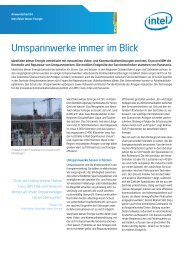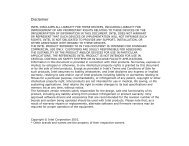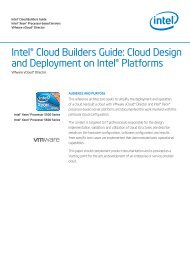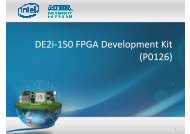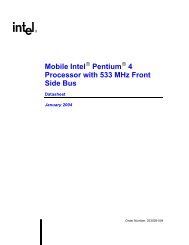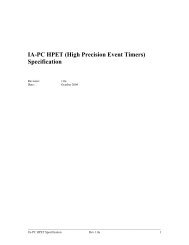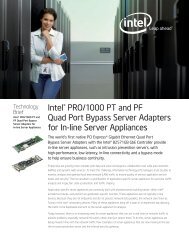Developing a Standard Enterprise Architecture Practice White ... - Intel
Developing a Standard Enterprise Architecture Practice White ... - Intel
Developing a Standard Enterprise Architecture Practice White ... - Intel
Create successful ePaper yourself
Turn your PDF publications into a flip-book with our unique Google optimized e-Paper software.
IT@<strong>Intel</strong> <strong>White</strong> Paper<strong>Developing</strong> a <strong>Standard</strong> <strong>Enterprise</strong> <strong>Architecture</strong> <strong>Practice</strong><strong>Intel</strong> <strong>Enterprise</strong> <strong>Architecture</strong>FrameworkA key step in the evolution of our standardpractice was developing the <strong>Intel</strong> <strong>Enterprise</strong><strong>Architecture</strong> Framework. This provides acommon language and way to categorizeactivities; the creation of this frameworkhelped us prioritize initiatives and drivestandardization on common tools, methods,and deliverables.The framework has four main components,as shown in Figure 2, including the <strong>Intel</strong>IT <strong>Enterprise</strong> <strong>Architecture</strong> DevelopmentMethodology, standard definitions ofarchitecture deliverables, a common tool setand repository, and governance. Together,these components determine how we buildenterprise architecture. Each component isdescribed in more detail below.INTEL IT ENTERPRISE ARCHITECTUREDEVELOPMENT METHODOLOGYThis methodology defines the standardprocesses for developing architecturedeliverables. We based this methodologyon an industry-standard framework. Itincludes five steps:1. Plan and align the specific architecture.This includes helping to ensure that thearchitecture has management supportand is aligned with business goals. It alsoincludes defining scope and key constraints.2. Identify, develop, or refine the baseline(as-is) architecture.3. Identify, develop, or refine the target(to-be) architecture.4. Perform gap analysis and recommendan implementation approach.5. Communicate results to all stakeholders.We employ this methodology to develop eachof the architecture deliverables described below.STANDARD DEFINITIONS OFARCHITECTURE DELIVERABLESWe standardized on three main architecturetypes: Strategic, Reference, and Solution.Each of these has Business, Data, Application,and Technical <strong>Architecture</strong> components.Strategic <strong>Architecture</strong>Strategic <strong>Architecture</strong> sets direction overthe longer term—typically 18 months to fiveyears—and helps drive planning discussions.It articulates the context, priorities, andplans that set the boundary conditions androadmap for the development of Referenceand Solution <strong>Architecture</strong>s over the prescribedperiod. Strategic <strong>Architecture</strong> is the mostabstract of the three architecture types.Reference <strong>Architecture</strong>Reference <strong>Architecture</strong> focuses on identifyingand standardizing a solution for a particulardomain; it provides a proven template solutionfor that domain. It also defines commonvocabulary, boundaries, and guidelines,with the goal of promoting integration,standardization, and reuse. A Reference<strong>Architecture</strong> is characterized by a mediumlevel of abstraction.Solution <strong>Architecture</strong>Solution <strong>Architecture</strong> describes a specificsolution in detail to enable its implementationin the near term. The focus is on defining asolution for specific IT projects, based on abusiness group’s requirements and plans.COMMON TOOL SET AND REPOSITORYAs we centralized our architecture practice,we needed to make architectural informationavailable in a consistent, reusable formacross <strong>Intel</strong>.IT <strong>Enterprise</strong> <strong>Architecture</strong>Development Methodology<strong>Standard</strong> process for developingenterprise architecture<strong>Standard</strong> Definitions of<strong>Architecture</strong> Deliverables<strong>Standard</strong>ized classification and definition ofenterprise architecture artifacts<strong>Enterprise</strong> Resource Base<strong>Enterprise</strong> modeling standardsand common objectsCommon Tool Set and Repository<strong>Enterprise</strong> Tool Set<strong>Standard</strong> tools for developingenterprise architecture<strong>Enterprise</strong> Repository<strong>Enterprise</strong> architecturerepository and catalog containingcurrent and legacy artifacts<strong>Architecture</strong> GovernancePrinciples, building codes, and governance for architectureFigure 2. <strong>Intel</strong>’s <strong>Enterprise</strong> <strong>Architecture</strong> Framework has four main components: the <strong>Intel</strong> IT <strong>Enterprise</strong> <strong>Architecture</strong> Development Methodology, standarddefinitions of architecture deliverables, a common repository and tool set, and governance.4 www.intel.com/IT
<strong>Developing</strong> a <strong>Standard</strong> <strong>Enterprise</strong> <strong>Architecture</strong> <strong>Practice</strong>IT@<strong>Intel</strong> <strong>White</strong> PaperAccordingly, in 2006 we standardized ona single enterprise architecture tool set.Previously, disparate groups of enterprisearchitects used different tools to createand maintain architectural information. Inconjunction with this, we created a commonrepository and a single portal for accessingour standard processes, templates, and tools.<strong>Standard</strong>ization made it easier to reuse andshare architectural artifacts such as diagramsand reports across <strong>Intel</strong>. This helped promotereuse and improve the quality and consistencyof deliverables.GOVERNANCEStrong governance is essential to develop aconsistent enterprise-wide practice and tohelp ensure that IT projects comply with theestablished architecture standards.Our initial steps included defining a set ofenterprise architecture principles that weuse to guide our architecture policies andstandards. These principles include enablingbusiness strategy, designing solutions withthe end user’s needs in mind, and addressingproduction support requirements.IT Building CodesWe created IT Building Codes designed to alignprojects to the relevant architecture. Theycontain policies, standards, and proceduresfor project areas such as security, usability,and hosting.Each project must assess which codes arerelevant and then use a scorecard to measurecompliance. Compliance involves adherence tospecific Blue Books, the use of the appropriatetools, providing required documentation, andother requirements. This self-assessmentmodel simplifies project management byallowing project managers to make moredecisions themselves, consulting with anenterprise architect only as necessary.Streamlining Decision MakingIn 2007, <strong>Intel</strong> IT adopted a standarddecision making methodology for useacross the IT organization, including theenterprise architecture group. By applyingthis methodology, we identified the needfor a top enterprise architecture technicaldecision making body. We call this body the<strong>Enterprise</strong> <strong>Architecture</strong> Council (EAC).The EAC approves, promotes, and enforcesarchitecture technical standards. It includes<strong>Intel</strong> IT senior management and is chaired bythe head of the <strong>Intel</strong> IT enterprise architecturegroup. The council creates committees thatrecommend ratification of changes to BuildingCodes; audit compliance to architecture; andapprove waivers. There are also workgroupsand committees focused on specificarchitecture topics.Talent DevelopmentTo translate business needs into technologyarchitecture, enterprise architects at <strong>Intel</strong> areexpected to speak the language of businessand acquire Business <strong>Architecture</strong> skills.We established a series of programs andforums to facilitate the development ofa broad, common skill set and to createa culture that unifies architects withdifferent backgrounds. For example, weprovided opportunities for enterprisearchitects to participate in an industrystandardcertification program, with thegoal of growing a worldwide, standardenterprise architecture competency. We alsoestablished an internal mentoring program.Our aim was to help architects becomeconversant with all four architecturaldisciplines—Business, Data, Application, andTechnology—and strengthen proficiency in bothstrategic and tactical architecture development.Ongoing forums provide opportunities forarchitects to learn and share information.Practitioners meet regularly to share bestknownmethods, network, and integrate <strong>Intel</strong>’senterprise architecture. These forums arereinforced by an annual internal conference,the <strong>Enterprise</strong> <strong>Architecture</strong> Summit.We also developed a handbook to helparchitects learn or refresh their memoriesabout specific enterprise architecture topicsand a newsletter to share interesting projectsand successes.Assessment andContinuous ImprovementBased on the results of a broad <strong>Intel</strong> IT internalreview in 2007, IT management requires thatthat we provide an assessment of continuingefforts to improve our enterprise architecturepractice.To do this, we use an approach called <strong>Enterprise</strong><strong>Architecture</strong> Management (EAM), which is anelement of the IT Capability ManagementFramework (IT-CMF). <strong>Intel</strong> IT initially developedthe IT-CMF, and it is now part of the researchand education agenda of the Innovation ValueInstitute, a consortium of more than 50 industryand academic organizations (www.ivi.ie).EAM defines eight capability building blocksin three broad categories: planning, practices,and people. Within each of these areas,we assess the maturity of our practice,assigning a score from 1 to 5. Maturity isbased primarily on two factors: reach withinthe organization—from individual projects toenterprise-wide—and process sophistication.To manage the assessment, we establisheda core team that includes participants fromkey groups. The assessment results inspecific recommendations for improvementin each area. We continue to conductthese assessments annually; they havebecome the foundation of a continuousimprovement process. By implementingthe recommendations identified in eachassessment, we have achieved significantimprovements, as shown in Figure 3.www.intel.com/IT 5
IT@<strong>Intel</strong> <strong>White</strong> Paper<strong>Developing</strong> a <strong>Standard</strong> <strong>Enterprise</strong> <strong>Architecture</strong> <strong>Practice</strong>Annual Maturity Evaluation Using the <strong>Enterprise</strong> <strong>Architecture</strong> Management (EAM) Assessmentfrom the IT Capability Management Framework (IT-CMF)<strong>Architecture</strong>Framework200820092010<strong>Architecture</strong>Processes<strong>Architecture</strong>Governance<strong>Architecture</strong>Value<strong>Architecture</strong>PlanningStrategicPlanningOrganizationStructure and SkillsCommunication andStakeholder Management<strong>Architecture</strong> Processes• Proliferation of a new version of the enterprise architecturetool set.• Inclusion of enterprise architects in several new key projects.<strong>Architecture</strong> Planning• Continued focus on separating Strategic <strong>Architecture</strong> fromProject <strong>Architecture</strong>.• Definition of unique enterprise architect roles focused onspecific business or technical areas.Strategic Planning• Continued use of the strategic frameworks to driveIT prioritization efforts.Organization Structure and Skills• Continued emphasis on enterprise architectureorganizational structure.• Increased opportunities for professional developmentincluding tools training, networking, mentoring, and the<strong>Enterprise</strong> <strong>Architecture</strong> Summit.Communication and Stakeholder Management• Stakeholder team more established and visible; increasedparticipation by stakeholder representatives.• Increased partnerships across organizations.• Increased communication through newsletter and blogging.Figure 3. <strong>Intel</strong> IT has seen continuous improvement in our enterprise architecture practice as the result of annual maturity assessments.RESULTS ANDCURRENT PROJECTSThe evolution of our enterprisearchitecture practice has resulted insignificant benefits to <strong>Intel</strong>. A standardarchitecture highlights substantialopportunities to reuse technology andprocesses across <strong>Intel</strong> IT, increasingproductivity.To encourage reuse, we initially tracked benefitsattributable to reuse across <strong>Intel</strong> IT. Forexample, we created the architecture for anauthentication mechanism that was thenreused across multiple projects. Since 2008,reuse has been considered an established partof IT culture, and we no longer need trackreuse in order to demonstrate the benefits.Examples of current architecture successesinclude service transformation architecture,IT consumerization, and enterprise customerinformation management.Service transformation architecture. <strong>Intel</strong>IT’s operations group is transforming the waywe provide services and support, using anapproach based on the Information TechnologyInfrastructure Library* (ITIL*) framework. Thisinvolves a shift away from supporting individualproducts to a strategy that delivers andsupports end-to-end services such as e-mail andconnectivity. This strategy is already achievingbenefits such as reductions in major incidentsand service calls. <strong>Enterprise</strong> architects helpedenable this transformation by mapping <strong>Intel</strong>business processes to IT services, acceleratingreuse of Solution <strong>Architecture</strong> across differentservice scenarios and helping to understandtotal cost of ownership. <strong>Architecture</strong> deliverablesincluded a new service interaction model thathelps <strong>Intel</strong> IT groups understand and defineservices, the dependencies between them, andthe value they provide to users.IT consumerization. An increasing number of<strong>Intel</strong>’s employees want to use their personallyowned handheld devices within the enterprise.This trend is known as IT consumerization.The number and variety of these devicesis increasing rapidly; today it includes smartphones, tablets, and personal PCs, and in thefuture will include new device categories thathave not yet emerged. <strong>Enterprise</strong> architectsworked with other <strong>Intel</strong> groups to create aReference <strong>Architecture</strong> that defines policyand the services we can support for devicesthat <strong>Intel</strong> IT does not manage. In 2010, <strong>Intel</strong> ITbegan letting employees use personal smartphones to access corporate e-mail and calendarservices. This initial groundwork helps <strong>Intel</strong>’sclient engineering teams more quickly supportnew devices, such as tablets, non-standard PCs,and a wider range of smart phones, as theybecome available.<strong>Enterprise</strong> customer informationmanagement. We defined a Strategic<strong>Architecture</strong> for customer informationmanagement that provides a vision for6 www.intel.com/IT
unifying all information about each <strong>Intel</strong>customer. Today, such information maybe held in variety of systems. The newarchitecture defines an end-to-end viewacross the customer life cycle, fromsales leads to support. This helps guideimplementation and improve data quality.CONCLUSIONOver the past decade, <strong>Intel</strong> IT hastransformed our enterprise architecturepractice into a strategic capability basedon a common set of methods and tools.<strong>Enterprise</strong> architects partner with <strong>Intel</strong>IT engineering and operations teamsto create solutions; the deliverables—Strategic, Reference, and Solution<strong>Architecture</strong>s—are used by all majorIT projects within <strong>Intel</strong> IT.Within <strong>Intel</strong> overall, there are now more than150 enterprise architects. About 60 workin our core enterprise architecture group,and 40 are associated with specific <strong>Intel</strong>business groups.We continue to work on improving our practice byapplying a structured assessment methodologyand focusing on the recommendations identifiedin each assessment. Our goal is to continue toincrease the reach and process sophisticationof our practice. This will help acceleratedevelopment timelines and reduce complexityand risk due to simplified design and reuse oftechnology and processes.FOR MORE INFORMATIONVisit www.intel.com/it to find whitepapers on related topics:• “Optimizing the Value of TechnologyInvestments with IT Strategic Planning”CONTRIBUTORSSteve BirkelDirector of <strong>Enterprise</strong> <strong>Architecture</strong>,<strong>Intel</strong> ITMartin CurleySenior Principal Engineer and Directorof <strong>Intel</strong> Labs EuropeMark KachmarekStrategic Planning Manager, <strong>Intel</strong> ITACRONYMSBDATEACEAMbusiness, data, applications,and technology<strong>Enterprise</strong> <strong>Architecture</strong>Council<strong>Enterprise</strong> <strong>Architecture</strong>ManagementIT-CMF IT Capability ManagementFrameworkITILInformation TechnologyInfrastructure LibraryFor more information on <strong>Intel</strong> IT best practices,visit www.intel.com/it.This paper is for informational purposes only. THIS DOCUMENT ISPROVIDED “AS IS” WITH NO WARRANTIES WHATSOEVER, INCLUDINGANY WARRANTY OF MERCHANTABILITY, NONINFRINGEMENT, FITNESSFOR ANY PARTICULAR PURPOSE, OR ANY WARRANTY OTHERWISEARISING OUT OF ANY PROPOSAL, SPECIFICATION OR SAMPLE. <strong>Intel</strong>disclaims all liability, including liability for infringement of any proprietaryrights, relating to use of information in this specification. No license, expressor implied, by estoppel or otherwise, to any intellectual property rights isgranted herein.<strong>Intel</strong> and the <strong>Intel</strong> logo are trademarks of <strong>Intel</strong> Corporation in the U.S. andother countries.* Other names and brands may be claimed as the property of others.Copyright © 2011 <strong>Intel</strong> Corporation. All rights reserved.Printed in USA0511/IPKA/KC/PDFPlease Recycle324599-001US


